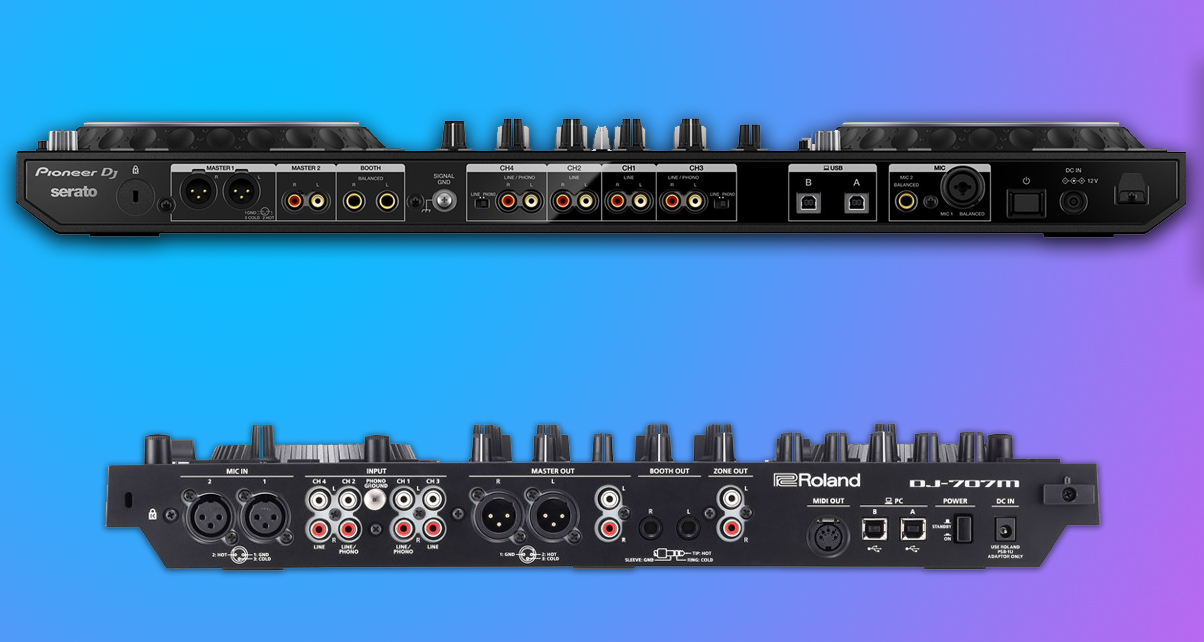Roland recently announced its latest controller the DJ-707M (see our review here), a controller designed specifically with mobile DJs in mind. This announcement came right after one of Pioneer DJ’s biggest announcements of the year, the DDJ-1000SRT (see our review here). Both controllers are high-end professional options and would make a great choice as a next purchase, but you may favour one over the other depending on your needs.
Size
The easiest difference to spot between the DJ-707M and the DDJ-1000SRT is the difference in size. The DJ-707M is small enough to fit in a large backpack while the DDJ-1000SRT would probably be best suited to being transported in its own zippered bag or even a flight case.
The size of the DJ-707M makes sense when you think that it was designed specifically with mobile DJs in mind. Saving any space or weight is a luxury when you need to transport sound and lighting gear. Roland did a great job of making the DJ-707M compact without sacrificing functionality: almost every feature you’d want as a mobile DJ can be found on it.
The DDJ-1000SRT, on the other hand, is unapologetically large. The size of this controller is a big reason why it can be compared to the club-standard Pioneer DJ CDJ and DJM kit found across the globe. There is also something to be said about the fact that to the majority of the audiences that DJs play for, a larger piece of gear that has more lights will look more professional than something that you are able to take out of a backpack.
Layout
The DDJ-1000SRT follows the layout that has ruled the majority of DJ booths around the world for the last decade. If you have ever had to chance to get comfortable with using CDJs and Pioneer DJ’s four-channel mixers you will feel right at home on the DDJ-1000SRT. If you are coming from the world of DJ controllers the DDJ-1000SRT makes a great stepping stone to the Pioneer DJ club set-up if that is your goal.
The layout of the DJ-707M is like most low to mid-range DJ controllers on the market but unassumingly includes powerful features. It follows what has now become the standard Serato DJ Pro layout: effects controls at the top with the pitch slider to the right of it, capacitive jogwheels, and a set of performance pads below each of the jogwheels. It’s been that way for Serato controllers for so long that at this point, if you are upgrading from a midrange Serato controller, you will feel right at home on the DJ-707M.
Jogwheel

Along with the difference in the overall size of these controllers, the size and type of jogwheel on these two are completely different. The DJ-707M features capacitive jogwheels that are smaller than what you would find on most mid to high-end DJ controllers. Although they are small they do function great, but If you have larger hands they could cause some problems.
The DDJ-1000SRT features jogwheels that are the same size and feature the same mechanical action found on Pioneer DJ’s media players, so club DJs will feel right at home with on this unit.
Four-deck control
At such a compact size Roland could be forgiven for making the DJ-707M a two-channel controller, but they instead packed two more channels into the mixer section with each jogwheel having dual layer controls providing even more flexibility. The Pioneer DJ DDJ-1000SRT also has four channels, which matches the DJM mixer layout that it is intended to mimic and also includes dual-layer jogwheels.
Dual USB ports
Both of these controllers follow the trend of higher-end controllers having dual USB ports allowing the use of a backup laptop or easy DJ changeover. In a mobile situation having a second USB port provides an emergency backup if something were to happen with your main DJ laptop. If you find yourself taking gigs where you are not playing the entire night and have other DJs with you, having dual USB ports make it so much simpler to keep the music going.
Standalone mixer
Along with having the second USB port that can be used as an emergency backup option, both of these controllers can be used as stand-alone mixers in which you could plug an auxiliary source such and a CDJ, smartphone or tablet. These both can also be used with DVS if you have the proper Serato DJ Pro plugins if you are a fan of tactile vinyl control.
Serato DJ Pro compatibility
Both of these controllers are built to be used with Serato DJ Pro. Thousands of DJs around the world depend on it because it’s feature-rich and has proven to be reliable over the years. Plus, even if Serato DJ Pro is used by some of the biggest DJs in the world, it’s still very easy for beginners to understand.
Outputs

The DJ-707M and DDJ-1000SRT may have similar output options, XLR and RCA master outputs and booth output on 1/4″ jacks. The DJ-707M however, provides more flexibility – not only can you route different sources to different outputs, but you are also able to EQ each of the outputs and save these settings for future use. This is so powerful for mobile DJs and was not previously possible with other DJ controllers without the use of other gear.
Finally…
The DJ-707M and the DDJ-1000SRT have all the features DJs have come to expect from a modern high-end DJ controller. Four channels, standalone mixer capability, dual USB ports, great build quality, and compatibility with one of the most popular DJ software on the market. If you are in the market for a top of the line controller either of these controllers would make a great choice.
Which one should you go for?
If you are interested in the DJ-707M, chances are you are a mobile DJ. Although the DJ-707M is designed to be a mobile DJing powerhouse, that does not mean the DDJ-1000SRT would be a bad choice if you were primarily a mobile DJ. It all comes down to what features you feel are the most important to you.
If you run complicated PA speaker setups that require multiple zones the DJ-707M is strong in that department. If you want a controller that looks more visually impressive along with being quite capable, the DDJ-1000SRT may be more your style.
Which controller do you prefer? Why? Let us know in the comments.








